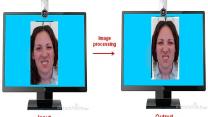
New facial paralysis rehabilitation software
Problem to be solved
“The mirror therapy” has been used for facial paralysis rehabilitation leading to an improvement in these patients. But there is still a need to improve this technique by automating the process and recording the data obtained to follow up the patients’ recovery.
Background
This software can be used to improve the existing mirror therapy and to be combined with the facial muscular rehabilitation treatment in peripheral facial paralysis patients.
This therapy could also be applied in other areas
such as:
– LOGOPEDIA, rehabilitation therapy for speech in different disorders, such as aphasia.
– MAXILOFACIAL, for assessment especially TMJ disorders to measure the mouth opening, overbite and others.
– DENTISTRY, measurement of the correction performed by brackets
Technology status
A pilot study has been performed in patients with peripheral facial paralysis and followed by a survey asking patients for satisfaction with the treatment, being the results almost 100% satisfactory. This study has been performed with a β-version of the software that will need further development. IP status: A trade mark registration and copyright will proceed. A patent application will also be filed for the software protection in the US.
Context
Facial paralysis is caused by loss of facial movement because of nerve damage. It usually happens on just one side of the face and is typically caused by skull fracture or injury to the face, head or neck tumor, stroke, Bell’s palsy, Ramsay-Hunt Syndrome and Guillain-Barre Syndrome. The incidence of sudden facial paralysis in American is of 40,000 persons per year. Current neuromuscular treatments are based on neurobucal massages and analytic movements. It has been demonstrated that vision of a symmetric image of the face can improve facial paralysis, this is called “the mirror therapy”. This is a known technique since the 90’s, initially used as a therapy for pain treatment of phantom limb syndrome in amputated patients. Some years later, this technique started to be used in patients with hemiparesis caused by cerebral injuries and nowadays it has become a useful technique for other pathologies. Some of the postulated theories to understand the mechanisms of this technique are the activation of the “mirror neurons circuit” or the interpretation of the mirror reflex by the. brain as an image corresponding to the paretic side activating the motor circuits injured and leading to ease the movement.
Technology
This is an improvement of the mirror technique by developing a software to create real-time symmetric images and to record data in order to maintain a following up of the treatment. Using this tool, the clinician will be able to record the improvement of each patient at the same time that the rehabilitation process is being performed. This could be a useful, innocuous and easy to apply tool, with no additional cost for patients with facial paralysis to improve movement regeneration. Moreover, the treatment will be combined with an app where the patients will be able to proceed the rehabilitation exercises, and to follow up the process with a mobile phone or a tablet from home; thus, making the rehabilitation process easier, faster and more effective.
Autors
Montesinos N (HUB)
Technology Readiness Level
TRL 5
What are we looking for?
Codevelopment
